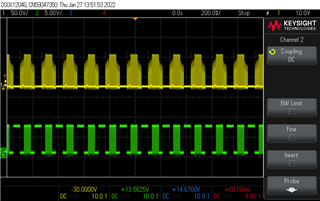Hi,
I am running my DRV8304S on 1x PWM mode.
The phase waveform is a perfect trapezoid when DIR=0 (INHC input). When DIR=1, the waveform looks like this:

As you can see, there are some stray PWM signals in between the trapezoids.
The input PWM signal (on the INHA line) is 25kHz, and even when I change the duty cycle across the whole range, I find these stray PWM signals.
What could have gone wrong? I do not think it is a board or firmware issue, since everything works just as expected for DIR=0. The only change that causes this is toggling a GPIO, setting INHC to 1.
Is there some configuration I can do with the DRV registers to deal with this?
Thanks and regards,
Vishnu Venkatesh








